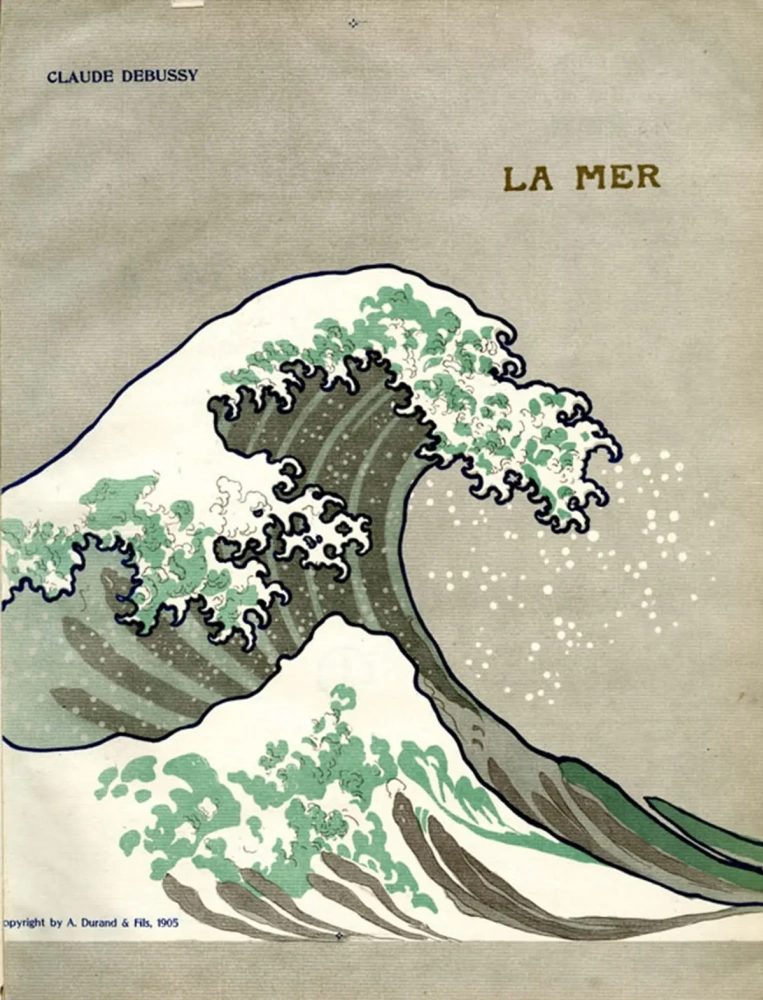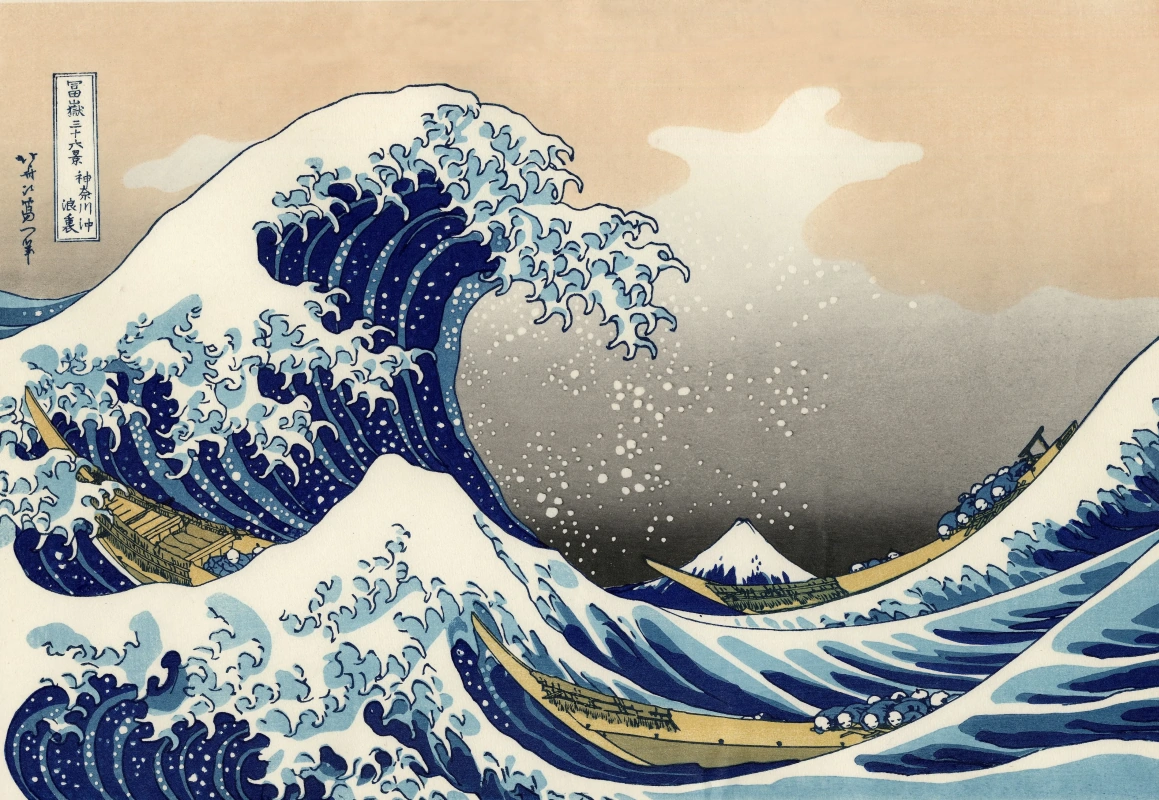увійти
Увійдіть на сайт
Залогіньтесь, щоб використовувати максимум функцій Артхіва
Большая волна в Канагаве
Кацусика Хокусай • Живопис, 1832, 25.7×37.9 см












Опис картини «Большая волна в Канагаве»
«Большая волна в Канагаве» - не только одна из наиболее известных гравюр Хокусая, но и один из самых узнаваемых образов японской культуры в целом. Это первый лист «36 видов Фудзи» – серии настолько популярной, что отпечатки с нее делали до тех пор, пока деревянные пластины, с которых они производились, не начали изнашиваться. Предположительно, с оригинальных досок Хокусая было отпечатано около 5 000 копий.
Конечно, не все они дожили до нашего времени: бумага менее долговечна, чем холст, и многие отпечатки были утеряны в результате землетрясений, пожаров, войн и других напастей. А уцелевшие листы заняли почетные места в собраниях по всему миру: лучших музеях США, Национальной галерее Виктории в Австралии и даже доме-музее Клода Моне в Живерни.
Не секрет, что японская гравюра стала в некотором роде праматерью таких европейских художественных течений, как модерн и импрессионизм. Но была и обратная связь: еще задолго до того, как первые импрессионисты открыли источник вдохновения в гравюрах Хокусая, будущий мастер обогащал свои познания в живописи по западным образцам, которые попадали я Японию контрабандными путями, ведь любые проявления европейской культуры в этой стране были строго запрещены.
Но благодаря голландским купцам в руки молодого Хокусая все-таки попадали офорты западных мастеров, и по ним он изучал светотень, реализм и пейзажную перспективу. Ему было суждено стать революционером в своей области. Дело в том, что до того пейзажи не были предметом изображения в японском искусстве ксилографии: их главным образом писали кистями на шелке или бумаге.
Более того, традиционно гравюра укиё-э охватывала лишь сюжеты из жизни японской знати, и живописание крестьянского быта никак не входило в прерогативы мастеров. Поэтому, как это ни парадоксально, «Большая волна в Канагаве» – самая что ни на есть «японская» гравюра, какой ее видит западный зритель – создана под существенным влиянием европейской культуры, без которой на ней точно бы не появились представители одного из наименее уважаемых сословий в иерархии японского общества – рыбаки.
Вместе с ростом популярности гравюры Хокусая множились и различные версии ее интерпретации. Наиболее очевидная из них – мастер изобразил бессилие и незначительность человека на фоне неукротимой стихии. С этого ракурса считается, что рыбаки на ксилографии плывут навстречу верной гибели и автор запечатлел несчастных за мгновение до того, как их суденышки разлетятся на щепки. В более широкой трактовке рыбаки выступают символом всего человечества в целом.
Но существуют и прямо противоположные точки зрения. По мнению российского культуролога-япониста Евгения Штейнера, западные искусствоведы «радикально неверно» воспринимают смысл гравюры: «Начать следует с того, что в японском искусстве движение в картине идет справа налево. Соответственно, рыбачьи лодки являют собой активное начало, они двигаются и внедряются в волну, в податливое аморфное начало, а некоторые уже прошли ее насквозь».
Далее, путем сложных выкладок, основанных на том, какими именно иероглифами подписывает название горы Фудзи на своей работе Хокусай (оказывается, в японской орфографии не все так однозначно) и их связи с ключевыми концептами буддийской философии, Штейнер приходит к выводу: «Картинка является визуальной репрезентацией буддийской картины мира – мира как колеса дхармы, вечно изменчивой подвижной стихии. Человек в такой картине мира оказывается не швыряемой щепкой, умирающей от страха и отчаяния, а естественным элементом непостоянства природы. Рыбаки Хокусая почтительно кланяются мощи стихии; они как бы поддаются, склоняясь и замирая в бездействии, но на деле они просто стараются вписаться в ситуацию и выйти победителями. То есть налицо картина гармоничных и подвижно-гибких взаимоотношений. «Большая волна» может быть названа воплощением японского представления о философии жизни – о быстротекучей, бренной и прекрасной переменчивости мира (укиё)».
Как бы то ни было, Хокусаю непостижимым образом удалось создать графически не такое уж и замысловатое, но беспрецедентно цитируемое и репродуцируемое произведение искусства. Где только ни встретишь «Большую волну в Канагаве»! Возвышается она и в виде скульптуры на одной из улиц Дрездена. Присутствует вместе с Фудзи на лого известного производителя спортивной одежды Quicksilver. Встречается на игральных картах для настольной игры, паззлах, на монете республики Фиджи, которая будет выпущена лимитированной серией в 2017 году, на обложках нескольких музыкальных коллективов. Даже в русской сказке нашлось место японской большой волне!
Феномену популярности культовой гравюры Хокусая посвящен один из выпусков документального цикла BBC «Частная жизнь шедевров». Что же так неудержимо манит нас в образе «Большой волны» вот уже на протяжении почти двух веков? Возможно, секрет в использовании мастером золотого сечения, на котором базируется композиция ксилографии. Причем даже не одного, а целых двух. Заснеженный пик Фудзи находится на пересечении воображаемых линий золотого сечения, а сама волна закручивается в почти идеальную золотую спираль.
Автор: Наталья Азаренко
Конечно, не все они дожили до нашего времени: бумага менее долговечна, чем холст, и многие отпечатки были утеряны в результате землетрясений, пожаров, войн и других напастей. А уцелевшие листы заняли почетные места в собраниях по всему миру: лучших музеях США, Национальной галерее Виктории в Австралии и даже доме-музее Клода Моне в Живерни.
С Запада на Восток
Не секрет, что японская гравюра стала в некотором роде праматерью таких европейских художественных течений, как модерн и импрессионизм. Но была и обратная связь: еще задолго до того, как первые импрессионисты открыли источник вдохновения в гравюрах Хокусая, будущий мастер обогащал свои познания в живописи по западным образцам, которые попадали я Японию контрабандными путями, ведь любые проявления европейской культуры в этой стране были строго запрещены.
Но благодаря голландским купцам в руки молодого Хокусая все-таки попадали офорты западных мастеров, и по ним он изучал светотень, реализм и пейзажную перспективу. Ему было суждено стать революционером в своей области. Дело в том, что до того пейзажи не были предметом изображения в японском искусстве ксилографии: их главным образом писали кистями на шелке или бумаге.
Более того, традиционно гравюра укиё-э охватывала лишь сюжеты из жизни японской знати, и живописание крестьянского быта никак не входило в прерогативы мастеров. Поэтому, как это ни парадоксально, «Большая волна в Канагаве» – самая что ни на есть «японская» гравюра, какой ее видит западный зритель – создана под существенным влиянием европейской культуры, без которой на ней точно бы не появились представители одного из наименее уважаемых сословий в иерархии японского общества – рыбаки.
Девятый вал
Вместе с ростом популярности гравюры Хокусая множились и различные версии ее интерпретации. Наиболее очевидная из них – мастер изобразил бессилие и незначительность человека на фоне неукротимой стихии. С этого ракурса считается, что рыбаки на ксилографии плывут навстречу верной гибели и автор запечатлел несчастных за мгновение до того, как их суденышки разлетятся на щепки. В более широкой трактовке рыбаки выступают символом всего человечества в целом.
Но существуют и прямо противоположные точки зрения. По мнению российского культуролога-япониста Евгения Штейнера, западные искусствоведы «радикально неверно» воспринимают смысл гравюры: «Начать следует с того, что в японском искусстве движение в картине идет справа налево. Соответственно, рыбачьи лодки являют собой активное начало, они двигаются и внедряются в волну, в податливое аморфное начало, а некоторые уже прошли ее насквозь».
Далее, путем сложных выкладок, основанных на том, какими именно иероглифами подписывает название горы Фудзи на своей работе Хокусай (оказывается, в японской орфографии не все так однозначно) и их связи с ключевыми концептами буддийской философии, Штейнер приходит к выводу: «Картинка является визуальной репрезентацией буддийской картины мира – мира как колеса дхармы, вечно изменчивой подвижной стихии. Человек в такой картине мира оказывается не швыряемой щепкой, умирающей от страха и отчаяния, а естественным элементом непостоянства природы. Рыбаки Хокусая почтительно кланяются мощи стихии; они как бы поддаются, склоняясь и замирая в бездействии, но на деле они просто стараются вписаться в ситуацию и выйти победителями. То есть налицо картина гармоничных и подвижно-гибких взаимоотношений. «Большая волна» может быть названа воплощением японского представления о философии жизни – о быстротекучей, бренной и прекрасной переменчивости мира (укиё)».
Космическая гармония
Как бы то ни было, Хокусаю непостижимым образом удалось создать графически не такое уж и замысловатое, но беспрецедентно цитируемое и репродуцируемое произведение искусства. Где только ни встретишь «Большую волну в Канагаве»! Возвышается она и в виде скульптуры на одной из улиц Дрездена. Присутствует вместе с Фудзи на лого известного производителя спортивной одежды Quicksilver. Встречается на игральных картах для настольной игры, паззлах, на монете республики Фиджи, которая будет выпущена лимитированной серией в 2017 году, на обложках нескольких музыкальных коллективов. Даже в русской сказке нашлось место японской большой волне!
Феномену популярности культовой гравюры Хокусая посвящен один из выпусков документального цикла BBC «Частная жизнь шедевров». Что же так неудержимо манит нас в образе «Большой волны» вот уже на протяжении почти двух веков? Возможно, секрет в использовании мастером золотого сечения, на котором базируется композиция ксилографии. Причем даже не одного, а целых двух. Заснеженный пик Фудзи находится на пересечении воображаемых линий золотого сечения, а сама волна закручивается в почти идеальную золотую спираль.
Автор: Наталья Азаренко





